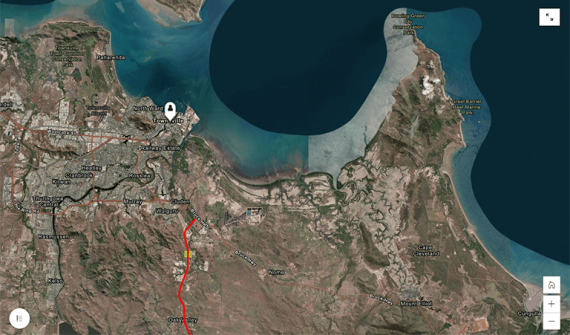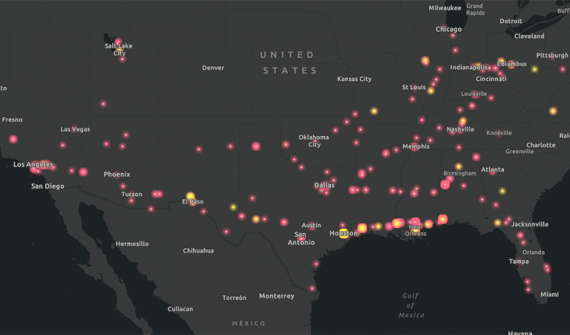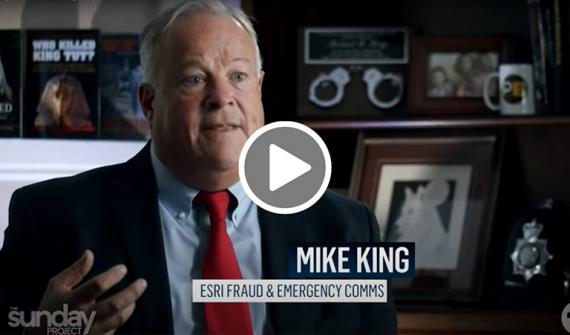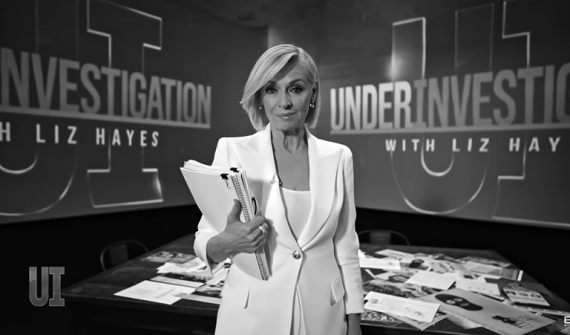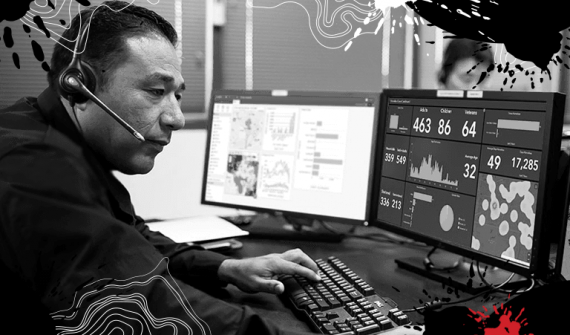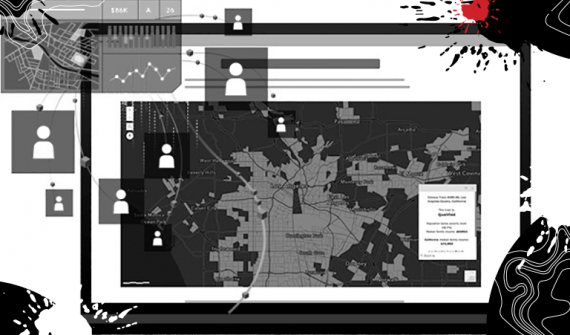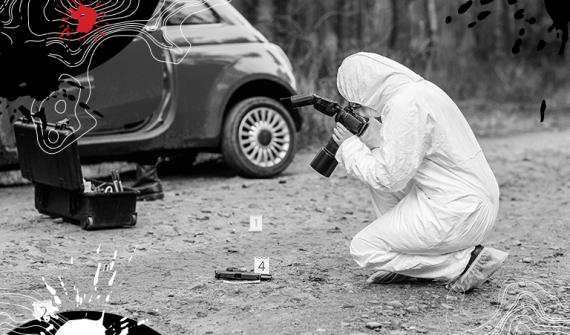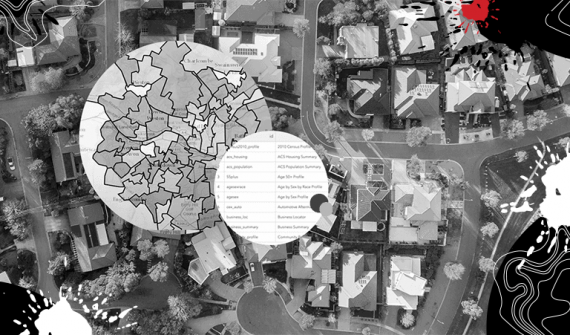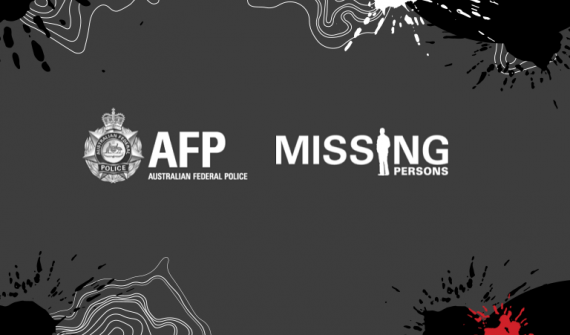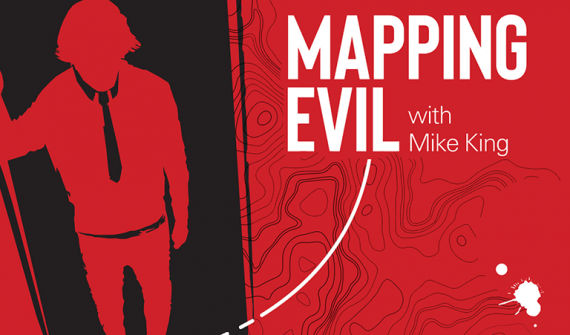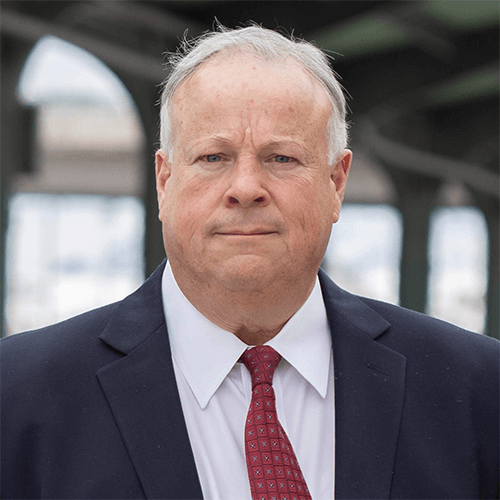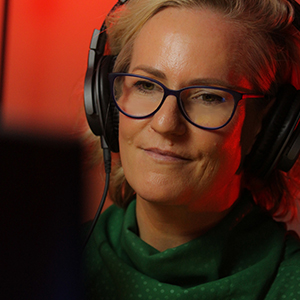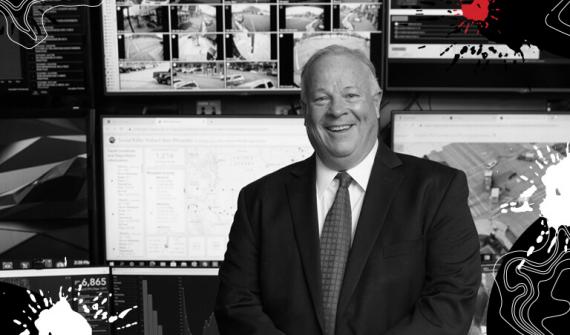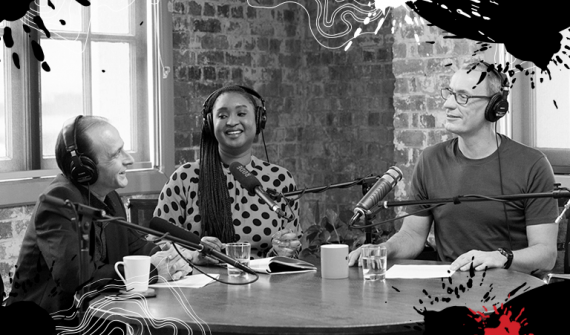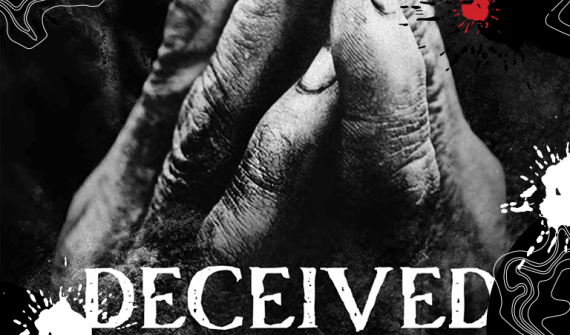When profiling evil, what lessons can we learn?
How can exploring the macabre crimes of Robert Ben Rhoades – the infamous Truck Stop Killer – help law enforcement officials half a world away?
Join Mike King and Tory Shepherd as they peel back the layers of the investigation into one of the USA’s most prolific serial sexual sadists. Peek into the workings of a truly evil mind and learn more about the police tactics that eventually brought Rhoades to justice.
Hear how the same science used to build a profile of a predator could unravel one of the most enduring mysteries behind Australia’s own ‘highway of death’ – the Flinders Highway.
Mike King brings an answer to the question of whether this long strip of road is indeed the killing fields of a serial predator – or something even more frightening.
“It was like reading a very familiar novel. And I remember we said, if she was shot in the head with a .25 calibre, we know who your killer is. And the deputy’s jaw dropped.”
Mapping highway predators
Explore crime mapping tech
Never miss an episode of Mapping Evil – subscribe now.
About the hosts
Get started with a free trial of Esri's mapping software.

If you have information about any unsolved crime or suspicious activity, then you can share what you know with Crime Stoppers, without saying who you are or getting involved. Call 1800 333 000 or go to crimestoppers.com.au.
- Click to view Route of all Evil episode transcript
Disclaimer: [00:00:00] The following podcast contains content of a graphic and violent nature, which may be distressing. Listener discretion is advised. The material covered is based on firsthand accounts and publicly available information. In producing this podcast, every effort has been made to show respect to the victims and their families.
Support for today's episode of Mapping Evil comes from the country's leading mapping tech and services provider, Esri Australia. To learn more about how as Esri tech is making a difference in crime analysis and public safety, head to Esri Australia at esriaustralia.com.au/crime.
Tory Shepherd: [00:00:42] I'm Tory Shepherd, and this is Mapping Evil with Mike King.
Mike King: [00:00:46] So sadistic and so sick, it's chilling
Tory Shepherd: [00:00:51] The podcast that investigates the geography of crime
Mike King: [00:00:55] Predators, roaming, our highways and our byways.
This was a big white international truck and this deranged human being welded bars in the back of that sleeper berth inside of there, and he put hooks and other things that he could use all kinds of bondage paraphernalia on. He would use this as a way to chain, to keep control of, and to punish his victims.
He fits the terminology of serial sexual sadist to a T.
Tory Shepherd: [00:01:30] Episode one. Route of all evil.
Being a journalist with a keen interest in the dark side of humanity. I can't wait to delve into the root of all evil with you as we uncover the untold stories behind true crimes from both America and cold cases in Australia with the help of criminal investigator royalty, Mike King.
Mike has been catching killers, tracking down serial predators and busting cruel cults for over three decades. He was trained by FBI profilers and has gone on to use geographic information systems, data, and mapping technology to become a world-leading investigator — not to mention a famous author and YouTube superstar.
Mike, before we get into how geography can link predators and their victims and help bust cold cases, let's start by looking at the cold facts of past murders on our highways.
Mike King: [00:02:32] It's chilling actually to think about predators, like the ones we're going to talk about and the fact that they're out roaming our highways and our byways.
Tory Shepherd: [00:02:42] Today, we're going to talk about the Truck Stop Killer.
Mike King: [00:02:46] This case really intrigued me from the very beginning, from a number of avenues. I think I first heard about this particular killer while I was sitting in a serial killer class in the auditorium at the FBI Academy. I was there with investigators from all over the United States who were handling these kinds of cases.
It really became a case that intrigued me. In fact, I taught this class for many years after using this very case that we're going to talk about as an example, because it really walks through many of the behaviours that we see in other predatory kinds of serial cases. But most importantly, Tory, the thing that really impacted me about this case as it eventually landed in my home state of Utah and in fact, the very last case that this individual was captured on — the body was dumped in my state.
Tory Shepherd: [00:03:35] And we will get all the way to that horrible finale.
But stay with us for now. We're about to dig into Mike's brain to hear about this case that he worked on, and then to also get his intel on an Australian cold case. So, Mike, before we meet the Truck Stop Killer, not a lot of traveling happening lately. Can you take us on a quick journey to Texas, Illinois, Utah?
What are these states like? I'm picturing long highways, deserts, mountain in the distance. What, what are these states like? Are they similar?
Mike King: [00:04:07] Well, the thing that's really interesting is are they're very diverse and it makes me think a lot of Australia and the many different ecosystems that I've been in as I've travelled your country.
For instance, Texas and Arizona are very dry and arid with huge areas where there is nothing but desert and cactus and just a very light brush in the countryside. It’s hot, it's near the Mexican border. It just really is a unique, beautiful place — and yet it's also butted up against, by the Gulf.
So there's a high humidity down there — you have desert where there's relatively no humidity and then near the ocean, the humidity is just stifling at times. I'm going to end with Utah, but as you move up into Illinois, it becomes just this incredibly lush environment. It's green, folks don't need to put out sprinkling systems in their yards to keep things green — It just rains nearly every day and the humidity is so high, it reminds me a lot of when I was up in the Northern Territories and some of the lush areas I saw up there.
But then you get to Utah — of course I live in Utah and I love it — but when you get down into the red rock area of Utah, where Zion National Park is and Arches National Monuments and those areas, it reminds me so much of going out to Uluru.
When I was there walking around near Ayers Rock, I just felt like I was at home, so it really is akin to being in your country.
Tory Shepherd: [00:05:45] Oh, that beautiful ochre, I love it. Now. Robert Ben Rhodes, the Truck Stop Killer. One of the striking things about this guy was his truck. He was a sexual sadist and he built himself what I read in the paper was described as a travelling torture chamber.
Mike King: [00:06:06] This was a, an 18-wheeler we call them here in the US. This was a big white international truck. It had — if you can kind of envision this — a big square nose cab that just went from the ground, straight up.
Right behind the front seats was what is called a sleeper berth, a place where truck drivers can pull over on long-haul routes, climb into the back where there's a bed where they can sleep and then get right back on the road again.
Well, this deranged human being took that one step further and he actually welded bars in the back of that sleeper berth, and he put hooks and other things that he could use all kinds of bondage paraphernalia on. He would use this as a way to chain, to keep control of, and to punish his victims — he was a terribly sick, human being.
Tory Shepherd: [00:07:00] The scale of Rhodes' crime: He was so prolific we're not even going to be able to go into all of his attacks — in fact, they don't even think they've pinned down all of his attacks and you can tell us a bit about how they think they may be even more that we don't know about. Could you talk us through his modus operandi?
Did I say that right?
Mike King: [00:07:18] Yeah. I love that because this thing called modus operandi is the kinds of things that an offender does in order to be successful —and they learn like all of us learn.
Whatever our trade is, when we have a mistake, we fix it and these predators are no different. He had created a system of doing things that seemed to work well for him. In fact, he actually told one of his victims: ‘I've been doing this for 15 years’ as he chained this woman to the inside of his cab and began to sexually assault her.
This particular individual was what I would call an opportunistic killer. He would drive the highways and byways and he would look for people that were broken down in their vehicle in need of assistance. He would offer assistance if it was a single female and sometimes, he took couples, but he would quickly execute whoever the man was in the couple. But he would be that person who would rescue them and offer them a ride.
As soon as he would get them into his vehicle, he would take immediate control —usually by executing the male if it was a woman travelling with a man, and then take the individual and put them into chains and get them into the back of his sleeper berth.
Other tactics that he used that were very successful is he would drive down the freeway and as women were passing him in his truck, he was actively taking photographs whenever there was a single woman in a car.
And we know this because we recovered a large quantity of photographs of single women in cars as he looked down from his high position in this truck. As the cars passed him, if he saw someone that he was attracted to, he would follow them to a freeway exit that they took for a truck stop or a restroom break.
When they had gone into the toilet, he would then ambush them and take them into his truck — that was another way he would get them. He took advantage of things like sex trade workers who work out of the truck stops or people involved in drug trafficking and would turn those into his victim.
But I think his favorite victim was someone who was hitchhiking on the road and some of the cases we're going to talk about Tory actually focus on how he took a couple of those people who were hitchhiking.
Tory Shepherd: [00:09:35] Yeah. I was reading about how women, often prostitutes at truck stops, are called lot lizards.
Mike King: [00:09:40] Yeah, isn't that a, an attractive term. I mean, what kind of human being even refers to someone like that?
That’s the exact terminology he used in one interrogation when they talk to him about a woman who had been involved in some sex trade work out of a truck stop, he said ‘Hey, what's the big deal she's just a lot lizard’.
Holy cow, this is a human being and he somehow can just dehumanise them by calling them something like that.
Tory Shepherd: [00:11:27] Okay. Well, let's get to some specifics. Can you tell us about, I guess, you know, the cases that the victims and incidents that really showcased what kind of guy he was?
Mike King: [00:11:39] I'm going to share four cases that happened over four months back-to-back to show how out of control this particular predator was.
What we've seen is that there's actually a buildup process that occurs with these kinds of predators. In the beginning, they might be very organised and they take all kinds of precautions, but in this particular case, I think part of what led to him being captured is he started to become disorganised in the way he did things and he started to act more quickly — one event after another.
He said, ‘I've been doing this for 15 years’ so if we took this idea that once a month — in the cases we're going to talk to — he took, murdered, abducted and sexually assaulted people every single month that we're aware of, imagine how many there may have been in this perpetrator's background.
I want to just go back to January of 1990, when this beautiful woman named Patricia Candice Walsh fell in love with a kid named Douglas Zyskowski — you just can't make up names like this.
These two newlyweds were living up in the northwest of the United States in Seattle, Washington, and they determined that one of the first things that they wanted to do was to become Christian missionaries for that first year of marriage to go out and just bless the lives of other people and spread the Christian gospel.
Tory Shepherd: [00:13:08] So there are really good kids trying to do good in the world.
Mike King: [00:13:12] Absolutely. These are the kids that you're proud of, that they care about serving and doing other things. They made the only decision they could make and decided that they were going to hitchhike from Seattle to Georgia — the deep south in the United States which I call the Bible belt — where there's so much religion discussed.
They were going to go down there to be missionaries. They’re hitchhiking just outside a little place in Texas and along comes Robert Ben Rhodes, who pulls over in his truck and he offers them a ride.
They get and are grateful, and he by all accounts was very charismatic welcoming people and talking to them. After a few miles, and once he's outside of the Houston area, Rhodes stops and suddenly pulls out a small caliber weapon — a 25 auto — shoots Zyskowski in the head and dumps his body in the desert.
Tory Shepherd: [00:14:16] And how old are these guys? These newlyweds.
Mike King: [00:14:19] They're in their twenties. Think about this Tory: Imagine how terrifying it would be to witness something like that and then have the person say: now do what I tell you or you're next.
You've just witnessed how committed this sicko is and now you're faced with a decision: Do I jump out of the car and flee? I think about how people would be so paralysed by fear — he immediately gains control of her.
Tory Shepherd: [00:14:48] I often wonder that: whether I would be a flee-er or a flight-er or if I would just be paralysed by fear. One of my deep fears is that I would be the sort of person who would be paralysed.
Mike King: [00:14:58] I think that's something that a lot of people experience, and it goes back to some of the things that we try to teach about making decisions now about how you're going to react in certain situations so that you don't have to think about those processes.
Tory Shepherd: [00:15:25] She's just seen her brand-new husband shot dead and now he's turned to her and said your mine, basically.
Mike King: [00:15:33] Correct. What he does with this victim, and with many others, is he has to change her appearance because law enforcement's now looking for a beautiful, long haired red head, he's got to change that. So, he does what he does with most of his victims: he cuts her hair, changes her clothing and puts her — either clothed or unclothed — in the back of the vehicle.
He keeps her for one to two weeks where he sexually assaults, starves and terrorises this human being until he eventually takes her to a remote area of Utah — where I live — gets her out of the vehicle, shoots her twice in the head.
One of the disgusting things that this guy did was, he would always display the victim in a very exposed way. He fits the terminology of serial sexual sadist to a T.
That's the first case.
Tory Shepherd: [00:16:31] I'm trying to imagine: a big truck thundering down a highway and inside is a secret torture chamber — and he's kept her in there for one or one or two weeks.
Mike King: [00:16:40] Imagine what that one or two weeks of hell was like for that a woman.
I get so angry when I think about that and think about what kind of an individual would violate someone in that manner. I'm going to just say it again: a serial sexual sadist.
So, the next one is really interesting: it’s a young woman by the name of Nicole Tuttle — and this is one month later and he’s travelling in Southern California.
This is 2,000 miles away from Texas, whereas Zyskowski is killed; and 700-800 miles from Utah where Candice Walsh has been killed.
A month later, this truck driver who travelled all over the United States is now in southern California and he picks up a hitchhiker named Nicole Tuttle. He chains her and assaults her for two weeks in his vehicle —very similar modus operandi as his previous victim that we talked about.
I think it was just a little over a week that she was in his custody before she escapes. He's travelling through Houston, Texas — where we later learned he actually lives — and just for a moment, he leaves her unattended and unshackled. This kid has enough courage to bail out of his truck and take off running down the street with barely a stitch of clothing on and chains hanging off her.
Can you imagine the motorist that saw her?
Tory Shepherd: [00:18:19] I'm cheering for her right now, you know, and imagining it as a horror film: you see someone get away and you're, you're gunning for them, but then you're worried that he's gonna pull out his gun. So, what happened?
Mike King: [00:18:32] A motorist, thankfully, picks her up and immediately takes her to the police station.
She offers a description, police miraculously find Rhodes before he can get on a freeway and disappear, and they arrest him.
They take her over to identify him, and the moment she sees this individual who has been sadistically terrorising her, she curls up in a ball, says it's not him and can't testify.
She later apologises, but it's just too much emotionally for her. I can't blame her for that; but imagine she could have stopped things early on if she had been capable of testifying.
In no way am I saying that in a judgmental way, Tory, imagine what trauma this young woman went through.
Tory Shepherd: [00:19:19] Exactly, I would be paralysed by fear. So now let's get to the geographical nub of the matter. So, he's a long-haul trucker, he's got the freedom of being on the road all the time, the freedom of carrying, I guess, that truck with him that he can hide his victims in.
How do you start to think about catching a truck stop killer and working out that pattern on the landscape that he's making?
Today you would be able to pick up all the trucks GPS's, but in the nineties, what made him come unstuck?
Mike King: [00:19:51] Well, it was sheer luck on this particular case.
There's a challenge we call the three C's: communication, cooperation and coordination. It absolutely was not functioning well in law enforcement in the United States.
We're much different than Australia; we actually have 18,000+ police departments in our country. That's 18,000 different police chiefs, who all think they have the right answer, it’s 18,000 different communication systems and records management systems.
When it comes to sharing information, it really was problematic. What we've seen is a dramatic change for the good in recent years with technology where we've started to realise that we can share information more readily and create national databases that can help us stem this challenge and bring it together a little better.
Think about it, in his particular case, all he had to do is pick up a victim in one jurisdiction and within a few miles, he could be in an entirely different jurisdiction, and within an hour he could be in an entirely different state.
Each one of those organisations, those jurisdictions, when they have a violent crime, they look at it as a single episode within their jurisdiction — they don't look at it in aggregate across the country.
Today that's much different; we can start to analyse and look at comparative things like the type of victim and share data in a way that we couldn't back then.
Tory Shepherd: [00:21:24] Right, that sounds like a crippling system. But nevertheless, after the FBI had looked at this, and obviously individual police departments had looked at it, it landed in your lap because you are the maps and data guy, right?
Mike King: [00:21:38] It actually ended up in my lap in a much different way. I was teaching a serial killer class in southern Utah with my investigative companion, Greg Cooper and we had presented this case and after the discussion, we always invited the investigators to bring cold cases that they were having a difficult time solving.
In this particular case, the deputy sheriff — he's this massive man, about six foot four with a big Stetson cowboy hat on — brought his folder and he opened it up and he started showing us images of the unidentified body that they found in their community. As we looked at it, the victim was posed in the same way that we saw Rhodes had posed other victims. It was like reading a very familiar novel.
I remember we said: ‘If she was shot in the head with a 25 caliber, we know who your killer is’. The deputy’s jaw dropped and within a few weeks we had identified her husband in Texas and tied the two cases together. It was actually the last case that Rhodes was tried on. He currently sits in prison.
Tory Shepherd: [00:22:46] There you go. What would you do now if you read in the news about women being found in very different places? How would you start mapping out who it might've been? Who'd done it.
Mike King: [00:22:58] So it's interesting because once I started working with Esri, one of the first things I wanted to do was see if we could have sped this up with technology like we have today.
I took all of Robert Ben Rhodes truck stop records; every time a trucker goes through a new community, they have to go to a weigh station and make sure they're paying the proper taxes, every time he stopped for fuel or to sleep — we examined these locations and each of those locations, is a point on the map.
By using GIS, we can then start to see where all the points are on the map and then we can start looking at all the missing people that would fit within this particular killer's, preferential victim sphere and plot those.
Based on when they disappeared, and based on Rhodes’ locations, we could identify how many victims he could have potentially gotten to, taken control of, and then made it to the next point on the map where we have a date and time of him getting gas or checking in at a weigh station.
It was so eye opening as we looked at this and the numbers started to raise to the surface because now, we could use geography and the science of where and bring it together to identify what victims could possibly be tied to this offender, and then start to look at those cases individually.
What we have today is, is just so exciting and so empowering for law enforcement as we look at these massive amounts of data that are out there.
Tory Shepherd: [00:24:42] In a sense you've pioneered a new way of pulling out that map, right? So that you can then start to see other victims that might come with it.
Mike King: [00:24:50] Yes, and if they go to the website, they can look at examples of this, we call it link analysis, Tory, where they can look at these relational things based on real people that are still missing today, that Rhodes potentially could have victimised.
Now it becomes a fundamental financial decision at some point of how far you go. Some people suggest that Rhodes was responsible for somewhere between 50 victims and some members at the FBI think 300 victims that fit the profile of preferential victim, and the areas that I just described by using GIS.
We may never know how many victims this individual had, but once we had him locked away for the rest of his life with no possibility of parole, then it became more important to just try to identify who those victims are and get those families closure, and then to look at cases that are unsolved right now.
Tory Shepherd: [00:25:46] If you want to go and have a look that's on mappingevil.com.au. We're going to now talk about an Australian cold case. I think this is a really interesting little switch we're doing here because I had this vague memory that the Flinders Highway killings involved a serial killer and it turns out that's probably not really the case.
In a way, what we've got is a serial place rather than a serial person — a geographical area where people seem to run into trouble. It's like the Bermuda triangle: it's a place that tends to be quite dangerous for people. Can you give us an idea of Flinders Highway and what happened there?
Mike King: [00:26:29] I think the thing that was so intriguing to me about the Flinders Highway was that there are a number of homicides and missing persons cases — and I believe some unidentified bodies — that have turned up alongside that system or within a distance of the system that have caused people to say: Oh no, it's a serial killer on the Flinders Highway.
Tory Shepherd: [00:26:52] I think they even called it the ‘Highway of Death’.
Mike King: [00:26:55] If you can attach your crimes in hopes that somebody else might be held accountable for them, that makes it kind of interesting.
My experience has been that most of these predators are just not that smart and they are more interested in just satisfying whatever lust or desire, or whatever it is that's driving them at that particular moment.
I don't think most of them think that far ahead. I thought it was kind of interesting to go in first and look at the actual Flinders Highway and what it does; the cities that it connects to.
It is a connector, an artery that connected major metropolitan areas, bringing together communities and a whole lot of open space. We have people, over into…is it called Townsville?
Tory Shepherd: [00:27:50] Townsville it is, yes. I think we're talking 800 kilometres aren't we? Which is a long stretch, but maybe not that long for Americans and Australians. Townsville is kind of a fairly major metropolis.
Mike King: [00:28:03] It looks to me like it's got a huge metropolitan population, but then you, you start heading West to Mount Isa and we started to map all of these missing persons and homicides, one thing came right to the surface to me that I found interesting.
Most of the victims are taken pretty long distance and sometimes up to the north and into some pretty remote areas before they're disposed of. Now, the interesting thing I saw as we got on the coastline, the people attached to the Flinders Highway homicides extend as far as the Kearneys who are really far north up by Cairns.
Tory Shepherd: [00:28:50] I'm just going to say that for you in a Queensland accent.
Mike King: [00:28:52] Oh, please do
Tory Shepherd: [00:28:53] I'm from South Australia, so I'm going to put on an accent for this: Cairns. No offense to the Queenslanders listening.
Mike King: [00:29:03] That's perfect. But you know, it's strange to me that that individual, Reese Kearney, is tied to the Flinders highway.
I don't know exactly why, but many people attributed to this highway system. I started to think maybe it would be better to start looking at the victimology and the victim selection process to determine if you have a single serial killer, or maybe there have been multiple serial killers, or it could be natural events accidents, and this road becomes the boogeyman and the brunt of what this is. Maybe they really don't have anything to do with the highway.
Tory Shepherd: [00:29:45] Let’s talk about the victims because when we were talking about the Truck Stop Killer, we talked about that MO: basically young women. He had a very clear, preferred type, talk us through a couple of the killings on the Flinders Highway because there isn’t a demographic neat little box that they all fit into, is there?
Mike King: [00:30:04] No, no, in fact, I guess there were two buckets that really jumped out at me. The first one I'm going to use is the example of Tony Jones, a 20-year-old backpacker from Perth in 1982 who decides to tour Australia with his backpack.
Into his trip, he suddenly disappears — he falls completely off the map somewhere between Anthill Plains and Mount Isa. There were a couple of things that I thought were interesting because he disappears, but there's no additional dings against his bank account — it’s basically never tapped into.
You start thinking this could be a robbery — and I guess he could have been robbed for the $10 he probably carried in his backpack, but there’s no attempt to look into his banking account. This kid is just wiped from existence never to be heard from again. Imagine that family wondering every time they drive down the street and looking at every 20 year old male and wondering: Is that Tony?
Tory Shepherd: [00:31:14] Is that him? Just not knowing. And I know that the family kind of over the years have talked to the press and talked about rewards and possible leads — they've never had a chance to grieve properly.
Mike King: [00:31:26] These cases are so distressing and there are so many victims attached to them. To those who are listening who are family members of someone who's missing, please know how our heart aches for you as you try to find some solace in where they are or what's happened.
Now, in this particular case I found it interesting the police received an anonymous letter which said: “I believe body of AJ Jones is buried in or near Fullerton Riverbed within a hundred yards West, South side Flinders Highway in Lochiel”
Tory Shepherd: [00:32:00] Lochiel, yes. That's very specific, isn't it? I mean, that's a lot of detail. It's not just some crank. It could well be a crank, we don't know, but it's not just he is by the lake. It's very detailed.
Mike King: [00:32:15] This is really interesting because law enforcement did exactly what they had to do — you don't leave a stone unturned. They went out, they searched the area. They didn't find anything.
I think later, a prisoner had claimed to have killed a person in that area, but there's no connection that's found. I wrote myself a little note as I was looking at this, I wrote psychic next to me, I wonder if the person who sent this note was a psychic.
Just this weekend, we were assisting law enforcement and family in the search for a missing woman in the state of Colorado, and I was shocked at the number of psychics that came out of the woodwork.
Tory Shepherd: [00:32:58] I am a massive skeptic, but are you saying you believe in psychics?
Mike King: [00:33:04] I'm going to answer your question by not answering
Tory Shepherd: [00:33:08] Like a politician, Mike!
Mike King: [00:33:10] I'm going to say that I don't know of any investigator, including myself, that hasn't chased many leads as a result of psychics. When I run out of leads, how could you not chase some of these.
Tory Shepherd: [00:33:23] No stone unturned.
Mike King: [00:33:25] I had the responsibility of investigating cult crimes for many years, you can only dig up so many parking lots before you start to say, I just can't quite buy this.
But there are cases left and right where psychics have been able to identify the location, so they have to be followed.
It’s strange when you receive an email like we did this weekend, that said go five paces from the big rock and this coordinate and dig three feet down and you're going to find the body. Those become really challenging.
So, when I saw this letter I wondered if it was attributed to someone like a psychic. It very well could have been a body.
For anyone that's gone out into the woods to find the wallet they dropped while they were hiking, finding a piece of evidence in a big area like these areas are, is next to impossible. Even when you know where you're going to go look.
Tory Shepherd: [00:34:30] As we're saying there are all these different murders, these bodies found in different situations. Another kind of high profile killing was the MacKay sisters. What can you tell us about that?
Mike King: [00:34:39] In comparison to Tony Jones who disappears, in this case we have to look at it with an entirely different set of lenses. Little Judith and Susan Mackay are either going to school or returning from, and the last they're seen is at a bus stop in Townsville.
They're later found just off of the Flinders highway in the Anthill Creek area and one of the children had been sexually assaulted, one of the children had been stabbed and the other one had been strangled.
Clearly, in this case, sexual assault was part of the motivation for that killer, which is much different than the case of this 20-year-old boy.
Thinks about the mentality or the psyche of a serial killer. For a serial killer, sometimes it's about numbers, but those would be more of the kind of mass murderers than a serial killer.
Serial killers are very specific; they're driven by fantasy.
If they were looking at someone like Tony Jones, I don't see that it would be probable that it would be the same person looking at little children and sexually assaulting them. It just doesn't fit the way they do business.
Tory Shepherd: [00:35:51] It's almost like serial killers tell themselves a story, right? They get themselves into the narrative of: this is what I do, then enacting the same thing again and again and, as you said, perfecting how they do it.
Mike King: [00:36:03] Absolutely. It’s so polar opposite between Jones and the MacKay children that it makes me think these are individual episodes, individual predators.
Tony Jones may not even be a predator; it could just be that it was an accident that happened alongside the Flinders Highway.
The investigators theorise that these children may have tried to run away — it's more probable that the suspect focused on one and had to get rid of the other in my opinion. The thing that was so strange was the school uniforms being folded, neatly, and tucked away in their school bags and their little straw hats and shoes and their socks folded all tucked inside.
That’s really compelling stuff to read, but red flags are raised about if this is really important to the investigation. Was that normal behaviour? Did the children fold their clothes that way at the end of the school day to ride home in something more comfortable? I don't know.
Tory Shepherd: [00:37:05] It could just be an absolute red herring, right?
Mike King: [00:37:07] Absolutely. What becomes more interesting is the reports of witnesses who see the girls in this blue vehicle with an adult male driver. One witness later claims that one of the children looked like they had been crying and were overheard saying: Are we there yet? When are you going to take us to mummy?
That really tells us a lot about what may have been the guise that was used to get those children into the vehicle with him.
“Your mum just told me to pick you up here at the bus stop, cause she's at the hospital”
We start to really see things that tell us about the character of the offender and the method and modus that they use in order to gain control of those children. Does that make sense?
Tory Shepherd: [00:37:52] Yeah, it absolutely does. When I was reading about all these different crimes, some of them could be the same bucket, but they're quite disparate and over a very long period of time.
It doesn't sound like a serial killer. So, looping back to Truck Stop Killer, is there something about a highway that brings together the victim and the predator at the right time?
People are on the move; they might be vulnerable. Maybe it is younger people who tend to be moving around a lot more — is there something about a highway that helps them meet in a very unfortunate way?
Mike King: [00:38:28] I think there are a couple of really important things that come to mind from my perspective.
First, is the highway as a vehicle to get where the predator can safely commit the crime. In the case of a sexual assault, is it merely just an avenue to get him away from an urban setting and a lot of people to the countryside where he can have more anonymity or more privacy to commit the crime?
He wants to be successful. He’s not picking it because it's not familiar to him — the highway teaches us a lot about the offender and the site in which these victims are disposed, because they're not going to go somewhere that they're unfamiliar with, or they're fearful that they might get caught.
They're like any other predator they're going to work in a way that helps them be successful, so we have to think about that.
We have to think if it’s just functional that this is a predator that is a route driver, a road like the Flinders Highway could merely be an avenue to move from one spot to another, on a regular basis — a travelling salesman that every Thursday has to make a run to a certain location.
It could be functional, and fundamentally the only way that they would go, so they would have to pick up a victim and then drop them somewhere along the road. That’s where we start to see these things tie together.
As I look in totality at all these cases, I have to start saying the cases that originate over in the Townsville area seem to go shorter distances. The cases that originate in Mount Isa seem to go longer distances. Why is that?
We start to examine behaviour and movement and other kinds of things.
One victim was hitchhiking up from Melbourne. The one thing that's very clear is the victim assumes a very high-risk position by hitchhiking across such a broad span of ground.
Tory Shepherd: [00:40:19] I think that's a very good take home: Hitchhiking is not such a good idea. Of course, we’re not blaming victims and yet you would talk about where you sit on the spectrum of victimhood?
Mike King: [00:40:32] We call it the victim risk continuum, and it is such an important thing to constantly remind ourselves. Are the decisions that we're making increasing or decreasing my risk of being victimised. Deciding to save the $20 bus fare and hitchhike is a decision that increases one's risk.
Tory Shepherd: [00:40:55] Very well put. I feel like there was an Aha! moment when you were talking about the Truck Stop Killer and how once you input it, all that data the pattern just emerged like one of those magic eye pictures.
That made me wonder it be worth doing mapping all the unsolved murders and missing people cases across Australia to see whether there are particular clusters or patterns that can be drawn out of it?
Mike King: [00:41:29] Absolutely, and I think not only just look for those clusters of numbers, but look at it based on population so that you really see the rate of disappearance: for example, two people per thousand disappear every month in a particular community.
Well, it may be that there is a much smaller community where there are four people that are disappearing per thousand population.
We have to start using GIS and analytics to look at the information and actually make it understandable and usable.
If I were to look at the United States, for instance, we average over 800,000 missing people every year. 87% of those roughly return home, but that means 104,000 people are never heard from again in our country.
I would suspect that your country is very much the same in those numbers. Maybe not the 104, maybe not the 800, but those proportions would be very much the same.
Tory Shepherd: [00:42:26] And that’s about us done for the day so thank you to today’s sponsor, Esri Australia, whose mapping solutions help public safety agencies across the country predict and fight crime, track the criminals and keep us safe.
You can get a free trial of their software at mappingevil.com.au.
Mike King: [00:42:28] You’re a natural Tory and I just really enjoy exploring these with you, and I think that your insight is very representative of most people's insight.
The problem is, we sometimes fail to follow our insight and our promptings and we decide we know a little more than our gut's telling us.
Folks, please just keep thinking, am I increasing my risk, or decreasing my risk in the decisions that I make.
I can't wait to see you again. Tory
Tory Shepherd: [00:42:56] Words of wisdom, Mike, I'll see you next time.
Disclaimer: [00:43:05] If you found the content distressing, support is available from Lifeline on 131114.
If you have any information about any unsolved crimes, please contact Crimestoppers on 1800 333 000 or go to crimestoppers.com.au.
This is a Boustead Geospatial Technologies production.
This episode was narrated by me, Tory Shepherd, and Mike King.
Sound engineering by Fig Media with editing support from Kim Douglas, Gabi Paterson, Circuit3 and Pod Booth Studios.
Artwork by SuperScript and our executive producers are Raquel Jackson and Alicia Kouparitsas.
And finally, the production would not be possible without the support of Esri Australia.





 VIEW TRANSCRIPT
VIEW TRANSCRIPT